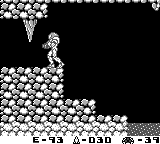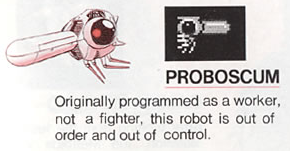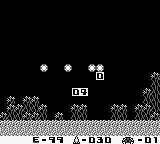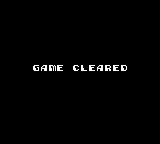Metroid II: Return of Samus
| Metroid II: Return of Samus |
|---|
|
Developer: Nintendo R&D1[1]
|
Metroid II: Return of Samus is best known as "that game between the first one and Super Metroid".
Contents
Unused Graphics
![]()
The numbers 3 and 8 are part of the font set used in the game's title screen and credits. The Metroid home planet (and the planet this game takes place on) is SR-388, so those tiles might have been meant for an unused intro or epilogue text like the ones in the first game.
Unused Save Points
There are two unused save point designs found in the game:
![]()
This alien statue appears in all three variations of the acid-flooded caves tileset (which start at $1E800, $1ED30, and $1F260 respectively). Unlike every other tile in these tilesets, these do not have an acid-submerged variant (although there would have been ample room for such). Despite their unusual appearance, they have the same collision properties as other save points.
![]()
This tile more closely resembles the save points used in the final game. It belongs to the ruins exterior tileset, which starts at $229BC.
Unused Sprites
| To do: Catalogue these things:
These unused sprites have no graphics associated with them. Investigate if they have any notable properties (either by themselves or their placement in the sprite list):
|
Stalactite
![]()
In the enemy graphics page starting at 1A120 there are graphics for an unused stalactite enemy. This appears to correlate with enemy ID $D2. The stalactite uses the default null enemy header, and therefore has no enemy AI routine associated with it. It also deals no contact damage, and is therefore intangible (except to the screw attack). It is unknown whether this was intended to do something such as fall and damage the player at one point, or if it was meant to be purely decorative.

Here is a screenshot of it hacked into a room in the original game that uses the appropriate enemy graphics page, showing what it might have looked like in context.
Sideways Autoad
![]()
![]()
Enemy sprite IDs $48 and $49 are for a sideways variant of the Autoad enemy. The graphics, sprite data, and hitboxes for it are all rotated 90 degrees counter-clockwise compared to the upright Autoad, and their graphics are also located in the same enemy graphics page (starting at 1A520). However, these sprites use the default null enemy header, meaning that they have no enemy AI associated with them. Also, they deal no contact damage, rendering them intangible (except to the screw attack).
It is unknown whether these were meant to be distinct enemies from the upright Autoads, or if at one point Autoads were intended to clamber along walls (similar to their behavior in Metroid: Samus Returns).
Gunzoo Projectile
| Frame 1 | Frame 2 (unused) |
|---|---|
Enemy sprite ID $58 is an unused frame for the Gunzoo's horizontal projectile. It has the same hitbox and contact damage of frame 1 (sprite ID $57) of the projectile's animation. Sprite IDs $59 through $5B are used by the projectile during its explosion animation. This second frame being unused is likely just the result of an oversight.
Right-Facing Proboscum
The Proboscum platforms are only found along a single wall in the game, and all of them are facing towards the left. However, there is a right-facing variant that can be spawned using enemy sprite ID $72, as can be seen in this screenshot:
This right-facing variant appears to be the default variation of the Proboscum, using sprite IDs $72-$74. The in-game left-facing variant is spawned in using sprite ID $6E, but the Proboscum's code immediately switches it to using sprite $72. The ID of $6E just acts as a dummy value to allow it to be placed on the map. (Other enemies with flipped variants, such as the Wallfire and Autrack, follow this same design pattern.)
There are three blank sprite IDs ($6F-$71) between the two variants of the Proboscum. They use the same hitbox as the flipped version, but are intangible. It is possible that these sprite IDs pertained to the Proboscum, though they just as easily could have been for a scrapped enemy.

Curiously, the instruction manual shows the unused variant of the Proboscum. While it is likely that it was intended to be placed somewhere at some point, the screenshot in the manual gives no clues as to where. In fact, given that none of the enemy screenshots in the manual show any background graphics, it is possible that this screenshot was taken from a sprite editor, rather than in-game.
Unused Item Orbs
Some item orbs exist in the game's code, but are not found in the game:
| Sprite ID | Orb Contents |
|---|---|
| $94 | Spring Ball |
| $96 | Energy Tank |
| $98 | Missile Tank |
The sprite IDs that could have been used as item orbs for the energy and missile refills (had they used the default enemy header for items), $9A and $9C, are instead used for the Blob Thrower enemy and the Arachnus orb respectively.
Note that the Spring Ball orb is distinct from the orb containing Arachnus. Nevertheless, the Spring Ball the orb contains still does not display a message at the bottom of the screen.
Also note that because the item orb is not part of the common sprite graphics, the energy and missile tank orbs will appear glitched unless they are placed in a room where the orb graphic is loaded.
Omega Metroid Projectile
| To do: Add a comparison gif of the animations. |
![]()
Sprite ID $CD is an unused animation frame for the explosion of the Omega Metroid's projectile. It has a small hitbox and deals the same damage as the other frames of the projectile (12). The normal ending point of the animation is sprite ID $CC. This sprite not appearing could either be the result of an off-by-one error on the coder's part, or it could have been intentionally removed for aesthetic reasons.
Missile Door

Missile doors are normally only seen on their right side, but it turns out that every missile door in the game has a corresponding left side. This left side of the missile door cannot be seen by normal means, except by clipping through the doorway using the select glitch or invulnerability frames.

The reason for this is that the missile door sprite ($F8) is actually a large sprite that has both the left and right doors at the same time. The door even has special code to spawn its explosion in the proper place depending on whether it was destroyed from the left or the right.
Interestingly, while the enemy sprite IDs directly following the missile door ($F9-$FC) do not have graphics associated with them, they share the same hitbox. Sprites $F9 and $FA are tangible, while $FB and $FC are intangible. It is possible at one point that the door was going to have a proper opening animation similar to Metroid 1.
(Bizarrely, enemy sprite ID $FD also uses the missile door hitbox, but this sprite is used by the disappearing Flitt platforms when they are intangible.)
Unknown Message
Samus sprite ID $41 appears to be some sort of text string (like the "Press Start" and "Completed" messages that appear when standing on a save point). However, displaying it in a room with the font loaded does not render it legible, because the highest font tile index available in that case is $E2, while the lowest tile index in this sprite is $ED. Moreover, it does not correlate to any known character mapping. For completeness sake, this is what it looks like when the landing site is loaded:
The message is 10 sprites wide, and divided into two words of five letters each, with letters 4 and 5 being identical to each other. Judging by its placement in the Samus sprite list (immediately adjacent to the "Press Start" text), it is possible that this is an earlier revision of the "Press Start" text that assumed the text was drawn directly onto the tiles (similar to the "Start" and "Clear" text on the title screen). One problem with this theory, however, is that between the 3rd and 4th letters the tile index jumps from $EF to $F5, instead of being continuous like one would expect.
Credits Stars
| Normal | Fixed |
|---|---|
 |

|
The game has an array that defines 16 pairs of x/y positions for the starfield during the credits. However, due to a bug, the game only reads the first 16 bytes of the table that determines the initial positions, rather than reading all 16 coordinate pairs. The result is that the last 8 of the 16 stars start at a position of (0,0), overlapping each other to form a ninth star, instead of starting at their proper positions.
Ironically, this bug makes the credits appear less glitchy, due to how tight the Game Boy's limit of 40 sprites per screen is in this context. When the glitch is "fixed", stars begin to noticeably pop in and out of visibility due to how many sprites Samus's running animation uses.
Debug Mode
GameShark code 0101A0D0 or Game Genie code A02-52B-193 will enable some debugging features.
During the game, on pause you can:
- Adjust what items you have. Select a bit with Left / Right and press A to toggle the highlighted flag:
- flag 0: Bombs
- flag 1: High Jump Boots
- flag 2: Screw Attack
- flag 3: Space Jump
- flag 4: Spring Ball
- flag 5: Spider Ball
- flag 6: Varia Suit
- flag 7: Unused in-game
- You can also change the Arm Cannon weapon you want to use by pressing Up / Down:
- 00: Standard
- 01: Ice Beam
- 02: Wave Beam
- 03: Spazer Beam
- 04: Plasma Beam
- 07: Bomb Beam (Unused. When the beam hits a wall it leaves a bomb.)
- 08: Missiles
- Press Select to save current progress without any indications. Just one condition: the character must not be in the air. This causes the save text to be loaded over the enemy graphics when you start again, which can be fixed by moving to another area.
- Hold B and press Left / Right to adjust the number of energy tanks you have. Removing tanks doesn't produce a visible effect until the game is resumed.
- Hold B and press Up / Down to adjust your missile counter by 10 per button press after you resume the game. There are three internal missile counters in this game: the maximum possible value, and two current values of actually possessed missiles (when you change the first one, the second one will be automatically adjusted to the same value, for "counting" effect). This option does not decrease the maximum value counter, the only value is decreased here is the current missile value counter. When increasing, the maximum value + 10 is reloaded into the current value counter, both counters will have the same value until you decrease, so we can see some kind of "weird" behavior here because of that. All counters are 4-digit decimal counters, but the game only displays the lower 3 digits, however, you still can have as many as 9999 missiles, then warp to zero again.
- Hold A + B and press Left / Right to adjust the number of remaining Metroids.
During the game, in transitions between locations:
- Hold Select + B to warp directly to the final boss.
Unused Item Text
The item text list starting at $5911 has 5 entries that are never displayed:
SPRING BALL
ENERGY TANK
MISSILE TANK
ENERGY
MISSILES
The Spring Ball text is not displayed due to a conflict with the Arachnus boss fight.
The "ENERGY" and "MISSILES" strings correlate to the item IDs of the energy refill and missile refill, respectively.
Unused Screens
There are two more system handlers with the same structure as the Game Over screen. One displays the message "GAME SAVED", the other "GAME CLEARED". It is unknown, when they should be displayed, but most likely one is for saving during the game, the other is for clearing the state slot at the title screen. Both are unused in the final version.
To see any of them, use the Game Genie code ZEKAIZAE for the "saved" screen or AOKAIZAA for the "cleared" screen respectively.
The save screen, however uses the wrong tile data loading offset and size, so the text here is unreadable. But you can use two more codes AEVUNZEA+AONLXXAP to fix it.
Oddities
Offscreen Enemy Loading
In the second room of the game, if the player stands partway down the hill at the start of the room, a rhythmic percussive sound can be heard.
If the ROM is edited to allow us to pass through the floor, we can see that there are several "Rock Icicle" enemies (with incorrect graphics) placed offscreen (in fact, completely outside of the bounds of the room, if the room boundary is not disabled as it was in this video).
These enemies are not unused, but actually pertain to a different room --- specifically, the room in the main caverns that opens up after the first 5 Metroids are defeated that has a Metroid husk partially submerged in acid. The reason these enemies are spawned is twofold. First, it is because the rooms in this game are lumped together Tetris-style, resulting in potentially random rooms being adjacent to each other. The second is that the game tries to spawn in objects before they appear onscreen.
Presumably this could occur anywhere in the game, though in practice it not be detected if it happens at all. In order for this to happen, this requires an enemy to be placed near the edge a screen, and for the adjacent screen to permit the player scroll close enough to the edge for the enemy to be loaded and active. Moreover, in order for this to be detectable, the enemy needs to make sound independently of Samus (the Rock Icicle is one of the few enemies to do so).
Virtual Console Changes
- The 3DS version has a very subtle change on the title screen. Every 1,024 frames (about 17 seconds), the screen rapidly blinks 3 times in the 3DS version (as opposed to 4 times in the Game Boy version), though the blinking rate stayed the same. This change may have been made to reduce the risk of seizures, though it is dubious as to how much this helps.
- The Nintendo Switch Online version makes a similar change, but the details appear to differ slightly, further reducing it to 2 flashes, but the rate seems to be slower than the Game Boy or 3DS versions, making the flashes slightly longer.
References
The Metroid series
| |
|---|---|
| NES | Metroid |
| Game Boy | Metroid II: Return of Samus |
| SNES | Super Metroid |
| Game Boy Advance | Metroid Fusion (Prototype) • Metroid Zero Mission (iQue Prototype) |
| Wii | Metroid: Other M |
| Nintendo 3DS | Metroid: Samus Returns |
| Nintendo Switch | Metroid Dread |
| Metroid Prime | |
| GameCube | Metroid Prime (Prototype) • 2: Echoes (Prototype) |
| Nintendo DS | Pinball • Hunters (First Hunt Prototype) |
| Wii | 3: Corruption (Prototype) Metroid Prime (Wii de Asobu) • 2: Dark Echoes (Wii de Asobu) |
| Nintendo 3DS | Federation Force (Blast Ball) |
- Games developed by Nintendo R&D1
- Games published by Nintendo
- Game Boy games
- Games released in 1991
- Games released in November
- Games with unused areas
- Games with unused graphics
- Games with unused text
- Games with debugging functions
- Games with hidden level selects
- Games with revisional differences
- Pages with a Data Crystal link
- To do
- Metroid series
Cleanup > To do
Games > Games by content > Games with debugging functions
Games > Games by content > Games with hidden level selects
Games > Games by content > Games with revisional differences
Games > Games by content > Games with unused areas
Games > Games by content > Games with unused graphics
Games > Games by content > Games with unused text
Games > Games by content > Pages with a Data Crystal link
Games > Games by developer > Games developed by Nintendo > Games developed by Nintendo R&D1
Games > Games by platform
Games > Games by publisher > Games published by Nintendo
Games > Games by release date > Games released in 1991
Games > Games by release date > Games released in November
Games > Games by series > Metroid series
The Cutting Room Floor > Unimportant Awards > Game Boy games




